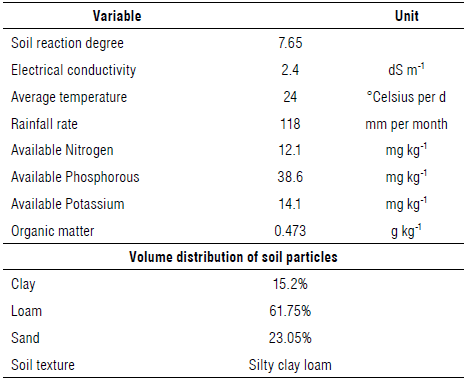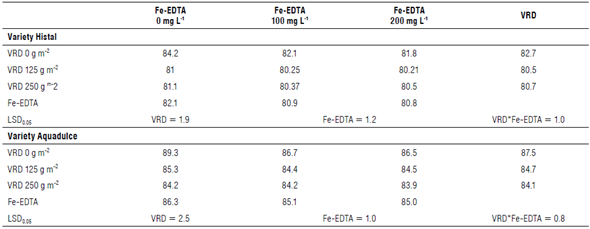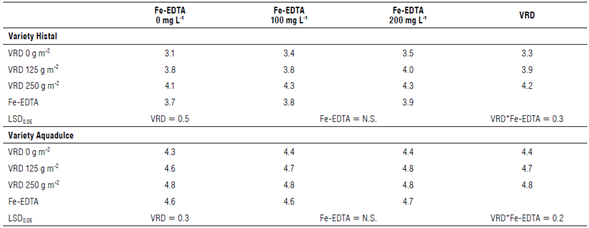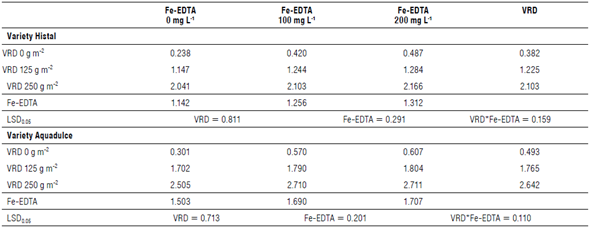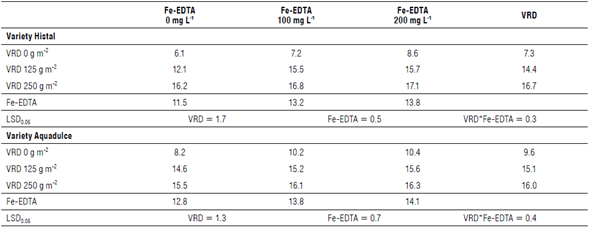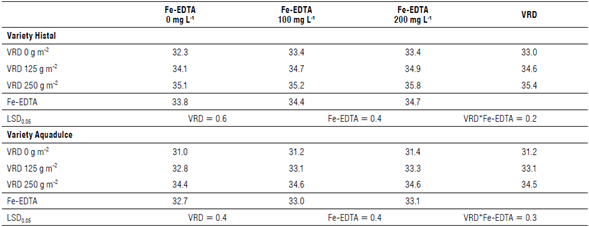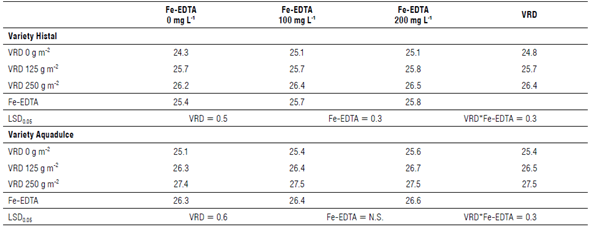Introduction
The broad bean is one of the old-world crops; it was one of the first plants cultivated in the Mediterranean basin (Albala, 2007) and was an important part of the nutrition system of the countries located to the east of the Mediterranean 6000 years B.C. (Smartt, 1990). It is a winter crop that belongs to the Fabaceae family (Stuessy, 2009). The seeds of broad beans contain about 11% water, 50-58% carbohydrates, 25-50% protein, 2% lipids and mineral nutrients including manganese, phosphorus, magnesium, and iron (Tull, 1997; Lewis et al., 2005; Duke, 2012). It is a rich source of nutrition for millions of people around the world (Nadal et al., 2005), particularly low-income societies. Broad bean plants enhance soil fertility as their roots are infected with nitrogen-fixing bacteria (Avila et al., 2005). The bacteria contain a leghemoglobin pigment (de Bruijn, 2015) that provides beans with effective iron, which is scarce in alkaline soils (Havlin et al., 2005).
Volcanic rocks can be exploited as an alternative for soil fertilization and a more sustainable agriculture (Plata et al., 2021). The primary oxides detected by X-ray fluorescence in the samples of volcanic rock dust were calcium oxide, silicon dioxide, aluminum oxide, iron oxide, and potassium oxide, with phosphorus oxide found at lower concentrations. The use of volcanic rocks solves an environmental issue associated with rock exploitation, providing an alternative for soil fertilization and a more sustainable agriculture (Ramos et al., 2017). Ramos et al. (2020) found that the addition of 3625 and 7251 kg ha-1 of volcanic rock dust significantly increased the dry weight of corn leaves and incremented the absorption of phosphorus, potassium, calcium, and magnesium. Fadhil and Jader (2020) showed that chelated iron sprayed on the vegetative parts of peas at concentrations of 150 mg L-1 generated a significant increase in the plant height (cm), number of branches per plant, total number of leaves, number of pods per plant, length of the pods (cm), weight of the pod (g), number of seeds per pod, 100-seed weight (g), and total seed yield for the broad bean. This research aimed to study the effect of volcanic rock dust (VRD) on the growth and yield of broad bean to compare it with the most common method of iron fertilizer (chelated iron Fe-EDTA).
Materials and methods
The experiment was conducted at the research station of the College of Agriculture and Forestry, at the University of Mosul (Iraq) in December 2018. This experiment consisted in adding 0, 125, and 250 g m-2 of VRD in broadcast application to rows in the soil one month after planting. The VRD was obtained from Plan "B" Organics (Medford, OR, USA). The chelated iron Fe-EDTA fertilizer was added by spraying the plants until they were completely wet with concentrations of 0, 100, and 200 mg L-1 one month after planting. These treatments were applied to two varieties of broad beans, Histal and Aquadulce. The area of the experimental unit was 6 m2. Cultivation was carried out on 4 rows at a spacing of 75 cm between rows and 20 cm between plants. Information about the physical and chemical properties of the soil used for cultivation and the rainfall rate and temperature during the growing season is shown in Table 1. The following variables were studied: plant height, leaf area index (LAI), number of branches per plant, contents of total chlorophyll and total iron (measured following the methodology of AOAC (1980)) in the leaves (at the beginning of the flowering stage), number of effective bacteria (Rhizobium fabae) nodules per plant, 100-seed weight, plant yield, and percentage of protein in seeds (measured at maturity).
Data analysis
The statistical analysis was conducted using a randomized complete block design with three replicates. The significant differences between the means of the treatments were tested using the least significant difference (LSD) with a probability level of 0.05.
Results and discussion
Plant height
The highest significant mean for plant height was achieved without adding VRD 0 g m-2 with values of 82.7 and 87.5 cm (Tab. 2) for varieties Histal and Aquadulce, respectively. Adding 125 and 250 g m-1 of VRD resulted in a significant decrease in plant height for both varieties, with no significant difference between them. When no Fe-EDTA was added, the highest significant average was achieved with values of 82.1 and 86.3 cm for varieties Histal and Aquadulce, respectively. Adding 100 or 200 mg L-1 Fe-EDTA led to a significant decrease in plant height, with no significant difference between these doses. This fact might be due to the effects of VRD and Fe-EDTA that stimulate an increase in the number of branches per plant (Tab. 4) and, consequently, lead to a decrease in the main branch length (Ali et al., 2020). The interaction of VRD 0 g m-2 and 0 mg L-1 Fe-EDTA obtained the highest significant mean with values of 84.2 and 89.3 cm for varieties Histal and Aquadulce, respectively. The interaction of VRD 250 g m-2 and 200 mg L-1 Fe-EDTA provided the least significant mean with values of 80.5 and 83.9 cm for varieties Histal and Aquadulce, respectively.
Leaf area index (LAI)
The highest significant mean for LAI was 4.2 and 4.8 for varieties Histal and Aquadulce, respectively, which was obtained by the interaction with VRD 250 g m-2. There was no significant difference from VRD 125 g m-2, while the treatment with VRD 0 g m-2 obtained the lowest significant mean with values of 3.3 and 4.4 for varieties Histal and Aquadulce, respectively. These results obtained when VRD was not applied are because it increases the leaf area (Tab. 3). Chelated iron Fe-EDTA application had no significant effect on the LAI for varieties Histal and Aquadulce. The highest mean was achieved by the interaction between VRD 250 g m-2 and 200 mg L-1 Fe-EDTA with values of 4.3 and 4.8 for varieties Histal and Aquadulce, respectively. The findings showed that the interactions between VRD 250 g m-2 and all Fe-EDTA levels were not significant; VRD 0 g m-2 with 0 mg L-1 Fe-EDTA showed the lowest significant interaction with values of 3.1 and 4.3 mg L-1 for varieties Histal and Aquadulce, respectively. The increase in the leaf area index may be due to the higher number of branches, as evidenced by Ali et al. (2020).
Number of branches per plant
VRD 250 g m-2 provided the highest significant means for number of branches with values of 5.1 and 5.6 for varieties Histal and Aquadulce, respectively, but it was not significantly different from VRD 125 g m-2 with values of 4.7 and 5.3 for varieties Histal and Aquadulce, respectively. The least significant means were obtained when no Fe-EDTA was added with values of 4.4 and 4.9 for varieties Histal and Aquadulce, respectively. This was due to the significant impact of VRD on LAI (Tab. 3), leaf chlorophyll and iron content (Tabs. 4 and 5), and the number of active bacteria nodules (Tab. 6). As for the application of Fe-EDTA, there were no significant difference levels in terms of the number of branches formed by the plant. The reason behind this may be that the quantity of iron used by the plant is lower compared to VRD (Tab. 6). Also, the interaction between VRD 250 g m-2 and 200 mg L-1 Fe-EDTA provided the highest means, 5.2 and 5.6, for Histal and Aquadulce, respectively. There was no significant difference for the interaction between VRD 0 g m-2 and all Fe-EDTA levels, and the lowest significant interaction for varieties Histal and Aquadulce showed values of 4.3 and 4.7, respectively. An increasing number of active bacterial nodules and nitrogen content in plants may lead to a higher number of branches, as nitrogen enters the formation of auxins (de Bruijn, 2015).
TABLE 4 Effect of volcanic volcanic rock dust (VRD) and Fe-EDTA and their interaction on the mean number of branches per plant in broad bean.
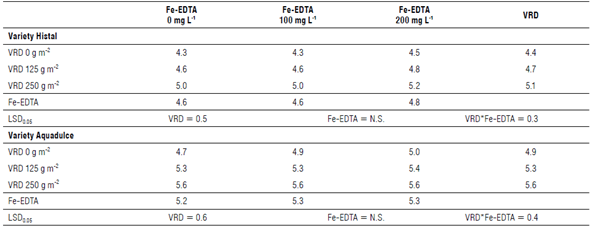
LSD - least significant difference test; N.S. - Not significant.
TABLE 5 Effect of volcanic rock dust (VRD) and Fe-EDTA and their interaction on the leaf chlorophyll content (μg cm-2).
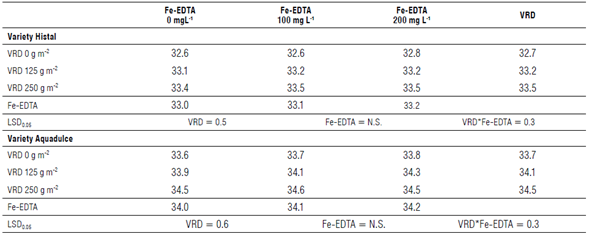
LSD - least significant difference test; N.S. - Not significant.
Leaf chlorophyll content
The addition of VRD 250 g m-2 resulted in a significant increase of the chlorophyll content in the leaves, with mean values of 33.5 and 34.5 μg cm-2 for varieties Histal and Aquadulce, respectively (Tab. 5). There were no significant differences with VRD 125 g m-2, with values of 33.2 and 34.1μg cm-2. When VRD was not added, the least significant means were 32.7 and 33.7 cm-2 for varieties Histal and Aquadulce, respectively. This might be because VRD contains magnesium, which is a component of chlorophyll. The addition of Fe-EDTA had no significant effect on the chlorophyll content in the leaf as it does not contain magnesium. The highest significant averages were obtained by the interaction of VRD 250 g m-2 and 200 mg L-1 Fe-EDTA with a value of 33.5 μg cm-2 for both varieties. There was no significant difference for the interaction between VRD 250 g m-2 and 100 mg L-1 Fe-EDTA with a value of 33.5 for variety Histal, while the interaction of VRD 250 g m-2 with 100 mg L-1 Fe-EDTA obtained the highest significant mean with a value of 34.6 μg cm-2 for variety Aquadulce. No significant differences were observed for the interaction between VRD 250 g m-2 and all the Fe-EDTA levels for both varieties. The least significant mean for the interaction between VRD 0 g m-2 and 0 mg L-1 Fe-EDTA was 32.6 and 33.6 μg cm-2 for varieties Histal and Aquadulce, respectively. The higher content of chlorophyll in leaves may be due to the increment in nitrogen produced by the root nodes, as nitrogen increases the formation of chlorophyll (Havlin et al., 2005).
Total leaf iron content
The highest means of leaf total iron content were obtained with VRD 250 g m-2 with values of 2.103 and 2.642 g kg-1 for varieties Histal and Aquadulce, respectively; the treatment without Fe-EDTA obtained the lowest mean values of 0.382 and 0.493 g kg-1 when VRD 0 g m-2 was added to the varieties. Also, the highest significant mean values of 1.312 and 1.707 g kg-1 were obtained by using Fe-EDTA 200 mg L-1 for varieties Histal and Aquadulce, respectively, and it was not significantly different from Fe-EDTA 100 mg L-1 that obtained a mean value of 1.256 g kg-1. The least significant means of 1.142 and 1.503 g kg-1 were obtained when Fe-EDTA 0 mg L-1 was added. The increase in the iron content in the leaf was due to the VRD and Fe-EDTA content (Tab. 6). The interaction between VRD 250 g m-2 and Fe-EDTA 200 mg L-1 obtained the highest significant means of 2.166 and 2.711 g kg-1 for varieties Histal and Aquadulce, respectively. There were no significant differences for the interaction between VRD 250 g m-2 and all the Fe-EDTA levels for both varieties. The lowest means were 0.238 and 0.301 g kg-1 and resulted from the interaction between VRD 0 g m-2 and Fe-EDTA 0 mg L-1 for Histal and Aquadulce, respectively. The significant effect of VRD on the leaf content of total iron may be due to the reduction in the degree of soil reaction due to its acidic effect in the soil (Ramos et al., 2020) increasing iron availability in the alkaline soil (Jensen, 2010).
Number of effective bacteria nodules per plant
The highest significant means of the number of effective bacteria nodules per plant were 16.7 and 16.0 for varieties Histal and Aquadulce, respectively (Tab. 7), when VRD 250 g m-2 was added. This treatment was not significantly different from VRD 125 g m-2, which obtained a mean value of 15.1 mg L-1 for the variety Aquadulce. When VRD was not added, the least significant means with values of 7.3 and 9.6 were obtained for varieties Histal and Aquadulce, respectively. The concentration of 200 mg L-1 Fe-EDTA obtained the highest significant means for the effective bacteria with values of 13.8 and 14.1 for varieties Histal and Aquadulce, respectively. There was no significant difference from 100 mg L-1 Fe-EDTA, which obtained an average value of 13.8 mg L-1 for variety Aquadulce compared to the treatment without addition of Fe-EDTA, which gave the lowest mean values of 11.5 and 12.8 for varieties Histal and Aquadulce, respectively. The reason is that VRD and Fe-EDTA contain iron that is a constituent of leghemoglobin that exists in bacteria nodules (Johnston, 2004). The use of VRD 250 g m-2 with 200 mg L-1 Fe-EDTA showed the highest significant means of effective bacteria nodules, 17.1 and 16.3, for varieties Histal and Aquadulce, respectively. There was no significant difference for the interaction between VRD 250 g m-2 and all Fe-EDTA levels or for the interaction between VRD 125 g m-2 and 200 mg L-1 Fe-EDTA. The least significant means were 6.1 and 8.2 for varieties Histal and Aquadulce, respectively, which resulted from the interaction between VRD 0 g m-2 and 0 mg L-1 Fe-EDTA.
Weight of 100 seeds
Significant differences were observed in the weight of 100 seeds; VRD 250 g m-2 obtained the highest means of 35.4 and 34.5 g for varieties Histal and Aquadulce, respectively (Tab. 8). The treatment without addition of VRD obtained the least significant means of 33.0 and 31.2 g respectively. This is due to the positive impact of VRD on LAI and chlorophyll and iron contents in the leaf, and on the number of effective bacteria nodes (Tabs. 3, 5, 6 and 7). The application of200 mg L-1 Fe-EDTA showed the highest significant means of 34.7 and 33.1 g for varieties Histal and Aquadulce, respectively. There was no significant difference with 100 mg L-1 Fe-EDTA, which obtained values of 34.4 and 33.0 g compared to the treatment without the addition of Fe-EDTA, which showed the lowest means of 33.8 and 32.7 g at 0 g m-2 Fe-EDTA. This is due to the positive impact of Fe-EDTA in terms of the number of active bacteria (Tab.7) . A positive relationship between the 100-seed weight, leaf area, and leaf area index was observed (Ali et al., 2020). The interaction between VRD 250 g m-2 and 200 mg L-1 Fe-EDTA obtained the highest significant means of 35.8 and 34.6 g for varieties Histal and Aquadulce, respectively. There was no significant difference regarding the interaction between VRD 250 g m-2 and all Fe-EDTA levels. The lowest significant averages were 32.2 and 31.0 g for varieties Histal and Aquadulce, respectively, for the interaction between VRD 0 g m-2 and 0 mg L-1 Fe-EDTA (Ali, 2020), showing the variation in the 100-seed weight trait.
Plant yield
The highest plant yield values were 33.6 and 33.6 g, which resulted from adding VRD 250 g m-2 to varieties Histal and Aquadulce, respectively; the lowest significant mean values of 28.9 and 30.8 g for both varieties (Tab. 9), resulted from not adding VRD. This result is due to the significant effect of VRD on LAI, number of branches per plant, number of effective bacteria, and 100-seed weight (Tabs. 3, 4, 7, and 8) . VRD interaction with 200 mg L-1 Fe-EDTA obtained the highest significant mean with values 32.4 and 32.5 g for Histal and Aquadulce, respectively, with no significant difference with 100 mg L-1 Fe-EDTA, which showed values of 31.8 and 32.0 g. The lowest significant means of 30.8 and 31.5 g for varieties Histal and Aquadulce, respectively, were obtained when no Fe-EDTA was added. This is due to the significant effect of Fe-EDTA on the number of effective bacteria and 100-seed weight (Tabs. 7 and 8). A positive relationship between plant yield, leaf area, leaf area index, and leaf chlorophyll content was observed (Ali et al., 2020). The interaction between VRD 250 g m-2 and 200 mg L-1 Fe-EDTA showed the highest significant mean for plant yield with values of 34.1 and 33.9 g for varieties Histal and Aquadulce, respectively, and there was no significant difference for the interaction between VRD 250 g m-2 and all Fe-EDTA levels. The lowest means were 28.2 and 30.4 g for varieties Histal and Aquadulce, respectively, resulting from the interaction between VRD 0 g m-2 and 0 mg L-1 Fe-EDTA.
Protein contents in seeds
VRD 250 g m-2 showed the highest significant mean for the percentage of protein in seeds with values of 26.4 and 27.5% for varieties Histal and Aquadulce, respectively (Tab. 10) compared to the least significant mean for the application of VRD 0 g m-2 with values of 24.8 and 25.4% for both varieties. This result is due to the positive impact of VRD in terms of the number of effective bacteria (Tab. 7). The application of 200 mg L-1 Fe-EDTA obtained the highest significant mean of 25.8% and was not significantly different from 100 mg L-1 Fe-EDTA. The least significant mean (25.4%) resulted from the treatment 0 mg L-1 Fe-EDTA to Histal, but variety Aquadulce was not significantly affected by Fe-EDTA application. This may be because the increase of carbohydrates was higher than proteins and eventually affected the contents of proteins. The interaction between VRD 250 g m-2 and 200 mg L-1 Fe-EDTA obtained the highest significant mean values of 26.5 and 27.5% for varieties Histal and Aquadulce, respectively. There was no significant difference for the interaction between VRD 250 g m-2 and all the levels of Fe-EDTA. The least significant means from the interaction between VRD 0 g m-2 and 0 mg L-1 Fe-EDTA were 24.3 and 25.1% for Histal and Aquadulce, respectively. This significant effect was observed by Ali et al. (2020) in most of the variables studied.
TABLE 9 Effect of volcanic rock dust (VRD) and Fe-EDTA and their interaction on plant yield (g)
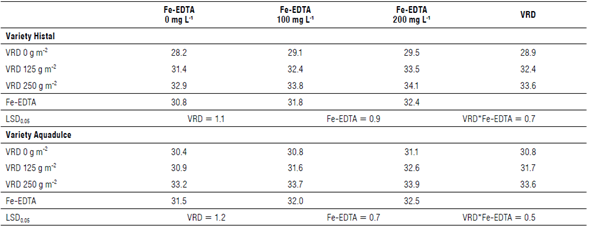
LSD - least significant difference test.
Conclusions
Volcanic rock dust (VRD) was more effective than chelated iron Fe-EDTA in terms of increasing effective bacteria nodules, growth (except for the plant height) and yield of both varieties of broad beans. The application of chelated iron had no significant effect on LAI, number of branches per plant, and chlorophyll content for both varieties. Additionally, it did not have a significant impact on the percentage of protein in the seeds of variety Aquadulce. The interaction of Fe-EDTA and VRD showed significant effects on all the variables.













